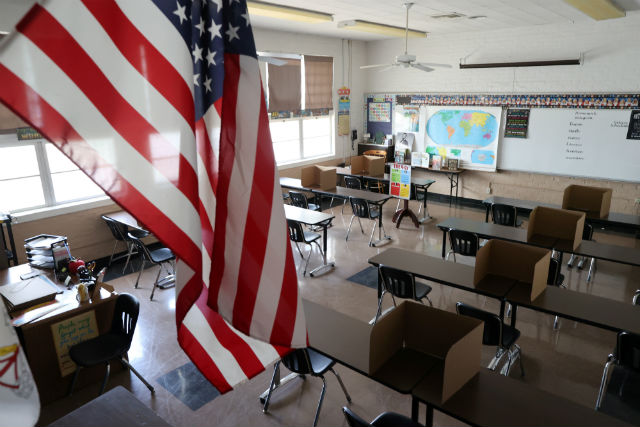South Bay teachers fight for contract changes



When Arminda Nigh clocks out of teaching sixth graders at Imperial Beach’s Oneonta Elementary, she clocks into her second job as a real estate agent.
“There’s no other way to make ends meet without it,” she said.
Nigh was one of dozens of educators who gathered last week in protest of lengthy contract talks with South Bay Union, where financial trouble and potential campus closures loom over the school district.
Already with half the students that it had a decade ago, officials expect enrollment declines to continue. The district has projected budget shortfalls for the next two years and the school board is weighing the possibility of closing at least one campus as early as the fall.
District leaders and the Southwest Teachers Association have yet to reach an agreement on several aspects of the contract after a year of negotiations. The union is asking the district to make adjustments to their current contract, including increasing wages and health benefits, reducing class sizes, providing fair evaluation procedures and setting new parameters for mainstreaming and combination classes.
It has proposed a 4% raise that would take effect over two years. The latest offer from the district was 2%, the teachers union said.
Multiple educators told inewsource they’re not just struggling financially. They’re facing challenges in the classroom, too, with high teacher-to-student ratios and an uptick in combination classes, which mix students of multiple grades together.
Teachers point to the district’s ending fund balance this year of $36.7 million as proof that it has funding to improve school conditions. The district’s board and superintendent received a raise this year, and teachers say they deserve one, too.
“While we don’t disagree that they work hard and they should be compensated, we also believe that the people that work directly with students should also be compensated,” said Vanessa Barrera, the union’s president.
But the district says a pay bump and additional support is not financially feasible at the moment. South Bay Union will need to be conservative with its reserves as it’s left to cover costs once covered by one-time funding provided during the COVID-19 pandemic, Superintendent Jose Espinoza told inewsource.
A majority of South Bay Union teachers have already seen smaller paychecks after the cost of health benefits increased in December, with some paying up to $300 more a month. Ruth Bajo Smith, a first grade teacher at Imperial Beach Charter, said the district covered all health benefits a decade ago. Now, she pays about $1,000 a month for her and her two children.
Most teachers at the district have kids and want to continue living in San Diego, but it feels like pleas for better pay are “falling on deaf ears,” said Bajo Smith.
“I run clubs for two hours every day after school and I tutor every morning for an hour just so that I can make up for the lack of funds that they’re paying us,” she said. “It’s just frustrating.”
While the district has tentatively agreed to increase its contribution to health benefits, it has yet to reach an agreement with the union on pay and other aspects. The two parties will come back to the table May 21.
Trouble in special education
The union wants the district to reduce class sizes and make room for students to mainstream — allow them to learn in classrooms with the general population.

Special education teachers at the district say they are challenged by large class sizes, upwards of 13 students who often all require one-on-one support to learn.
Some students need manipulatives — or hands-on objects — because language communication doesn’t work, said Amy Perrea, a special education teacher at Nicoloff Elementary. If they’re going to learn something they “need your actual physical assistance to do it,” she said.
“I only have two hands and I can only help that many at a time,” Perrea said.
But even staffing current special education classrooms is an issue at South Bay Union. Some of these classrooms have been without a teacher the entire year, with substitute teachers used to fill in the gap, multiple sources told inewsource.
Yazmin Valadez said it’s been frustrating seeing her son, a second grader at Mendoza Elementary, deal with different substitutes nearly every week. Her son, Edgar, has autism and struggles with change and behavior has to be addressed before students like him can learn, Valadez said, which is a challenge when dealing with the constant change of teachers.
She joined teachers at the protest last week.
“Every time they switch teachers he’s getting behind… I can’t stand this,” she said.
Research shows mainstreaming can provide both special and general education students with academic and social benefits.
Although mainstreaming is part of some students’ individualized education plans, the district is not leaving enough seats open for them to do that, said Norma Sahagun, another special education teacher at Nicoloff.
“If they are successful in math or reading, we want to push them in to be able to participate with their peers,” she said.
Espinoza said the district sees “the issue differently.” The current contract doesn’t prevent “special education students from being served,” he said, adding that they are not counted “differently” when setting teacher-to-student ratios.
Looming cuts
For the district, it’s not financially possible to give teachers a raise and put more teachers in the classroom, Espinoza said.
The district is projecting a budget shortfall of roughly $15 million next year and another $15 million the following year. By the 2026-27 year, South Bay Union is expected to cover deficit spending using 80% of this year’s ending fund balance, which includes reserves, Brent Watson, executive director of financial services, told district leaders in a letter last month.
Read the rest of the story at inewsource.org.











